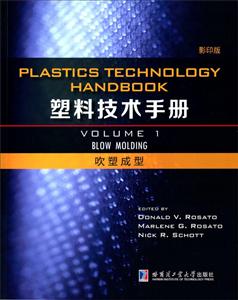塑料技术手册:Volume 1:吹塑成型:Blow molding
节选
[
《塑料技术手册 吹塑成型(1 影印版)》: Parison Swell The die flow influences parison behavior through molecular orientation, which manifests itself at the die exit as extrudate swell.Flow at the inlet of a die, where the streamlines are converging rapidly, involves a high rate of stretching in the flow direction.This produces a high degree of molecular orientation, and if the melt is permitted to exit immediately, as for flow through an orifice plate, there would be a very high degree of swell.However, if a long straight section,for example a capillary or straight annular die, follows the entrance, then molecular relaxation processes will lead to a disappearance of the orientation generated at the entrance, and as the die is made longer, the degree of swell is reduced.At the same time, however, the shearing in the die produces some axial orientation, and for a very long die, there is still significant swell resulting from this shear flow.If the die has an expansion or contraction section, this will introduce stretching, and this willintroduce orientation whose direction depends on the details of the die design.For these reasons, parison swellis very sensitive to die design. The melt leaving the die may exhibit sharkskin or melt fracture, which are irregularities in the surface of the extrudate that can affect the surface finish of an extrusion blow—molded container.This effect occurs above a critical shear stress in the die and is often the factor that limits the speed of an extrusion process.Extrudate distortion is most severe in the case of narrow molecular weight distribution (MWD) (chapter 1) high—viscosity plastics.Increasing the temperature or reducing the extrusion rate can sometimes eliminate it, but either of these actions will increase the cycle time.The use of an internal heater in the mandrelis a method to reduce the tendency toward melt fracture on the inside of the parison.The detailed origins of this phenomenon are not fully understood, but the shape and material of construction of the die and the formulation of the plastic are known to be contributing factors. ……
]
内容简介
[
《塑料技术手册》是大型综合性手册,通过阅读、学习本手册,无论是专业人员还是非专业人员,都会很快熟悉和掌握塑料制品的设计和制造方法。本册内容包括:吹塑过程,挤出吹塑成型,注射吹塑,拉伸吹塑成型,模具,塑料材料,设计。
]
目录
LIST OF FIGURESLIST OF TABLESPREFACEABOUT THE EDITORS6.BLOW MOLDINGINTRODUCTIONContainerIndustry SizeBLOW MOLDING PROCESSBlowing RequirementsAirflow ControlExtrusion versus Injection Blow MoldingBASICS IN PROCESSINGEXTRUSION BLOW MOLDINGExtruderMelt FlowParison SagParison HeadParison Wall ThicknessMachine DesignSingle—Stage DesignTwo—Stage DesignContinuous Extrusion DesignIntermittent Extrusion DesignINJECTION BLOW MOLDINGSTRETCH BLOW MOLDINGInjection Stretch Blow MoldingSpe MachinesExtrusion Stretch Blow MoldingDip Blow MoldingMultibloc Blow MoldingOther Blow—Molding ProcessesBlow Molding with RotationMOLDBasic FeaturesMaterials of ConstructionPinch— Off ZoneFlash ControlBlowing and Calibrating DeviceVenting and Surface FinishCoolingPLASTIC MATERIALBlow Molding and PlasticBehavior of PlasticsBarrier PlasticBarrier Material TypeBlow Molding Reinforced PlasticDESIGNBottle DesignIndustrial ProductsComplex Irregular ShapeOriented 3—D ParisonOther Design ApproachesSUMMARYHistory
封面

书名:塑料技术手册:Volume 1:吹塑成型:Blow molding
作者:Donald V. Rosato,Mar
页数:155
定价:¥50.0
出版社:哈尔滨工业大学出版社
出版日期:2015-06-01
ISBN:9787560350448
PDF电子书大小:98MB 高清扫描完整版
